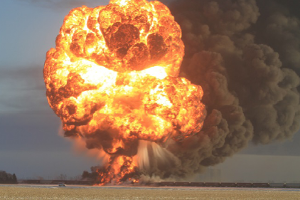
|
The Dec. 30th train accident near Casselton, North Dakota caused an estimated $6.1 in damage and promoted the evacuation of 1,400 residents.
A preliminary report issued by the National Transportation Safety Board (NTSB) lays out the facts and figures behind the derailments and collision involving two BNSF Railway trains, but does not identify a cause.
East meets west
The incident occurred when a westbound BNSF grain train derailed 13 cars and was struck by an oncoming eastbound BNSF petroleum crude oil unit train, resulting in the derailment of the head end locomotives and the first 21 cars of the petroleum crude oil train.
“After the collision, both crewmembers of the petroleum train exited the lead locomotive uninjured prior to initial ignition of ruptured tank cars and sequential explosions of other loaded tank cars. The crew from the grain train was not injured,” according to the report.
The speed factor
Data collected from the event recorders that were in the rear locomotives of both trains – as well as recorded data from the signal system in the area – indicated that both trains were traveling well below the maximum authorized speed of 60 for freight trains in the area.
The grain train was traveling about 28 mph when it went into an emergency brake application. The petroleum crude oil train was traveling about 43 mph when the train crew initiated an emergency brake application. The estimated speed at the time of the collision was 42 mph.
The accident occurred in daylight with weather conditions of overcast skies, a temperature of -1° F, and winds from the north at 7 mph.
NTSB investigators have completed the on-scene work in Casselton, ND. The investigation will continue at the NTSB headquarters in Washington, D.C.
Preliminary results of the investigation include:
- A total of 21 cars from the petroleum crude oil train derailed along with the two leading locomotives. Twenty of the tank cars were carrying petroleum crude oil; one was a hopper car carrying sand.
- Of the 20 tank cars that derailed, 18 breached (punctured).
- Initial estimates are that more than 400,000 gallons of crude oil was released.
- Between January 1, 2014 and January 3, 2014, investigators completed interviews of train crews and first responders. Interview transcripts will be included in the public docket upon release.
- A broken axle and two wheels were shipped to the NTSB laboratory in Washington, D.C. for further evaluation and analysis.
- Locomotive event and video recorders were also sent to the NTSB laboratory in Washington, D.C. for further analysis.
- The parties to the investigation include the Federal Railroad Administration, the Pipeline and Hazardous Materials Safety Administration, BNSF Railway, the Brotherhood of Locomotive Engineers and Trainmen, the International Association of Sheet Metal, Air, Rail and Transportation Workers[3], and Trinity Rail Car.
[3] Formally the United Transportation Union (UTU)

